Reinventing four wheels: 14 apps that are changing the way we get around
We’re all used to tapping on an app to help us find our way or book tickets for a trip, but the newest wave of transportation apps go far beyond that. The apps in this list are shaking up cities, industries, and our entire car culture. It’s not just Uber – there’s so much more happening.
While these transportation apps are still a niche experience for some of Asia’s most web-connected citizens, they give us a glimpse into the future and how we’ll get around by car.
China
As regular readers would expect of China, the nation has produced a wealth of apps in this new sector. They cover all kinds of four-wheel rides at pretty much every price-point.
But these car-ride and taxi-flagging apps have not been without controversy in China. While China’s taxi apps are free to use and the startups behind them make no money directly from either the riders or cabbies, users have to offer a sizable ‘tip’ – usually up to RMB 20 (US$3.28) – as an incentive for the taxi driver to avoid street-side pick-ups and come collect you, the app user, instead. In some cities, this fee has been banned or a limit has been put on it, as it’s disrupting the taxi industry too much and making some drivers turn down potential passengers on the roadside.
Other areas have tried different kinds of regulation. The biggest threat right now comes from Shanghai. In late February, authorities banned the use of taxi-booking apps during peak traffic hours. The Shanghai Municipal Transport and Port Authority went further by banning the use of transportation-booking apps for private vehicles that are licensed to carry passengers. That could directly affect – or even outlaw – Uber and other such private car services in the city.
Here are the main players:
Didi Dache
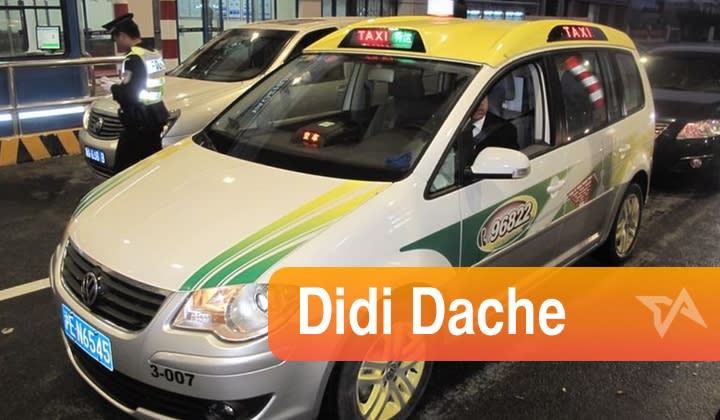
This service started the new year with a bang, getting $100 million in series C funding. China’s top web giant, Tencent (0700.HK), put in $30 million of that. Tencent is the maker of WeChat, the popular messaging app.
Just a couple of days after that investment, Tencent added Didi Dache as one of the online services integrated into WeChat. That allows WeChat users in certain cities to find a taxi within WeChat, book it, and then even pay for it via WeChat Payments.
With 355 million active users on WeChat, this gives Didi Dache the biggest reach in terms of users of any transport app in Asia – perhaps even the world. The app has been making a huge marketing push this year, including cash rewards for users and cabbies. The company has spent over $200 million on these subsidies so far. As a result of all this, the app is now used to book five million rides per day.
Aside from access within WeChat, Didi Dache has its own apps for iOS and Android.
Kuaidi Dache
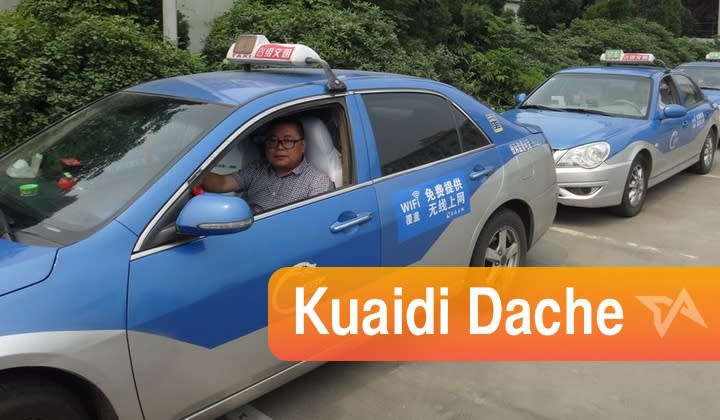
Kuaidi Dache is backed by a different Chinese web titan – Alibaba. That makes both Kuaidi Dache and Didi Dache pawns in a growing rivalry between Tencent and Alibaba in the realm of mobile commerce.
Alibaba first put money into Kuaidi in April 2013. By January of this year – a few weeks after Tencent tied up with the rival taxi app – the service had been integrated into Alipay, which is Alibaba’s ewallet app and service.
Like Didi and China’s other taxi apps, Kuaidi requires users to pledge a tip to get the driver to swing by. In practice, anything short of the RMB 20 maximum will not pull in a cabbie during a busy time of day. That makes these taxi apps a rather expensive accessory. While they might guarantee a ride, it means you’ll be paying double for short-distance taxi rides, as the pick-up fare in most Chinese cities tends to range from just RMB 10 to 15.
These companies make money from commission on the mobile data services they get cabbies to use – typically a 3G connection.
Kuaidi Dache has apps for iOS and Android.
Edaijia

Let’s move away from taxis. Edaijia is an unusual creation in that its focus is on drunk driving. More precisely, it’s designed to avoid driving whilst drunk by hooking up car owners with a designated driver. The app’s name literally means “E-designated driver.”
With over 5,000 qualified and star-rated drivers signed up, the app claims to connect people in major cities with a driver in just 13 minutes. Then the driver has to come find you, and will drive your car back home or wherever’s needed. Prices start at RMB 39 (US$6.36) in daytime until 9pm, rising in stages to RMB 99 (US$16) after midnight.
Edaijia has apps for iOS, Android, and Windows Phone.
PPZuche

This is from the same Singaporean startup as iCarsClub (see below). PPZuche launched in mainland China in October last year, marking the biggest and boldest – if not the first – attempt at sharing cars in the country.
If someone makes their car available for use on PPZuche, it gets fitted with an iCarsBox, a hardware device which provides keyless entry and GPS tracking. Everything is digitized, from renting a car to returning it. Payment is made as seamless as possible since the website stores users’ credit card details and charges them automatically.
Cars are relatively new as a middle-class necessity in China, and so trust issues will inevitably dog a service such as this. That’s partly solved by a screening process for renters: only drivers with two years experience, no more than three demerit points, and no car accidents in the past three years will be approved.
PPZuche has apps for iOS and Android.
Yidao Yongche

Yongche is often overlooked, but it’s China’s homegrown Uber – and it does a lot more besides. Yongche uses a mix of self-drive car rentals and UberBlack-style limo hires. While it lacks the glamor – or the singular focus – of Uber, it’s a massive company that has now grown to cover over 50 cities across China. It aims to be available in 100 cities next year – including some overseas, though the company has not given any details about those plans.
Yongche has also tackled the taxi-finder sector with its own DaChe Xiaomi app.
The startup’s most recent investment saw it pick up $60 million in series C funding.
Uber is now operating in three Chinese cities, in direct rivalry to Yongche. However, Uber doesn’t seem concerned about Yongche, as the US startup has a much more flexible service that does more than Yongche’s focus on airport pick-ups for its limo service. Uber wants to take off in China in the same way that Chanel bags have done – as something that says you’ve arrived as you arrive.
Yongche has apps for iOS and Android.
Uber (in China)

Uber launched officially in China in February this year, about six months after rolling out its “secret Ubers” in a soft-launch in the country.
Sam Gellman, Uber’s head of growth for Asia, says that Singapore saw slightly stronger traction than any other city in the first six months of operation. But Shanghai exploded in an even greater way, displaying the fastest growth in demand of any of Uber’s markets around the world. The company declined to reveal how many Shanghai rides it has completed since the soft launch last year. Uber also operates in Shenzhen and Guangzhou.
There’s one big, black cloud hanging over UberBlack in China with a regulatory threat in Shanghai over apps being used in private car fleets.
Uber has apps for iOS and Android.
Across Southeast Asia
A handful of companies – focusing just on taxis and limos – are trying their hand across the whole of Southeast Asia. In many countries, they’re clashing head-on with homegrown apps and services in the same transport sectors.
EasyTaxi
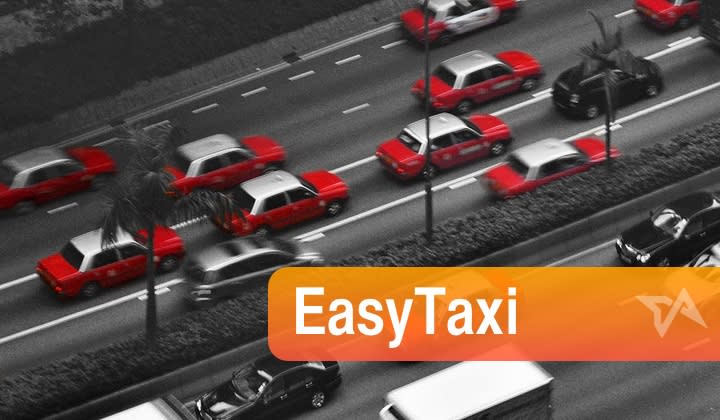
German startup dynamo Rocket Internet is battling a host of Asian cab app rivals with EasyTaxi. It’s now operating across a few cities in Malaysia, Hong Kong, Taiwan, Vietnam, the Philippines, Pakistan, and Thailand.
Backed up by Rocket Internet’s huge funding war-chest, it’s looking to lure taxi drivers to the service in many key Asian cities. As is the usual Rocket strategy, it’s not afraid of venturing into emerging markets even where there are few smartphone users – such as in Pakistan.
When we checked in with EasyTaxi Pakistan at the start of this year, it was seeing 100 rides a day from its 30 taxi drivers in Lahore. Hardly a hot and in-demand service. But it’s early days.
EasyTaxi has apps for iOS and Android.
(See: How Rocket Internet is getting into Pakistan on the ground floor )
GrabTaxi
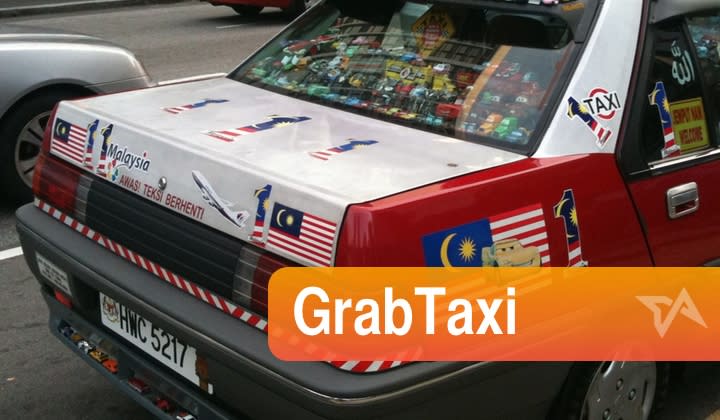
Malaysian startup MyTeksi has pan-Asian ambitions under its English brand, GrabTaxi. It’s a lot like EasyTaxi, and that’s the main rival the startup faces in the Philippines, Thailand, Singapore, Vietnam, and its home nation.
The app charges a flat extra fee for the pick-up; in the Philippines it’s PHP 70 (US$1.60), for example. The fact that you can rate taxi drivers is a plus point for it in some cities with less than reputable cab drivers.
The startup got funding last week to aid with its expansion.
GrabTaxi has apps for iOS and Android.
Uber
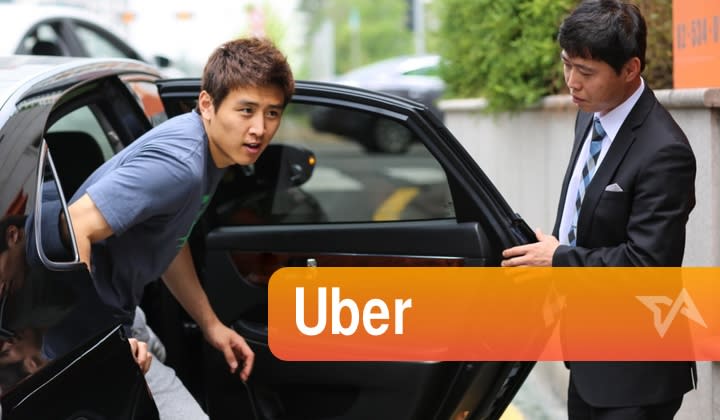
Uber first rolled into Singapore in October 2012. It then took a while to pop up in another Asian city, arriving in beta mode in Seoul in June 2013.
However, the service put the pedal to the metal last year, and now it’s present in 19 cities across Asia-Pacific.
Uber faces regulatory roadblocks in Manila, the capital of the Philippines, where transport apps are facing scrutiny from authorities for the first time.
Singapore looks to be a testing ground yet again for Uber as it experiments with UberX, which is the startup’s much more affordable – and much more disruptive – car-share service. The company is keeping quiet about UberX in Asia for now, but there are some cars out there in Singapore. Fares remain well below those of Uber’s flagship UberBlack tier. UberBlack charges a base rate of SG$7.00 (US$5.50) and a per-kilometer fee of SG$1.95 (US$1.50), while UberX charges a base fare of SG$3.50 (US$2.75) and a per-kilometer fee of SG$0.70 (US$0.55). UberX drivers in Singapore operate Toyota Corollas and Camrys.
As my colleague Josh Horwitz noted in his recent article on UberX:
Uber likes to refer to UberX as a cheaper version of UberBlack, and that’s true from the perspective of an average customer. From a regulatory perspective, however, the two tiers disrupt the traditional taxi industry from different angles. All UberBlack drivers hold licenses to operate commercial livery vehicles. In some markets this limits the pool of UberBlack drivers to those that work for big limo companies, while for other markets (in some US cities, for example), self-employed professional drivers qualify as well. Therefore, UberBlack threatens the taxi industry by pitting licensed livery vehicles – once thought to be ‘reservation only’ – against street cabs.
UberX is a different beast. In most US markets, anyone with a valid driver’s license can put on a tie, walk into a local Uber office, fill out some tests and paperwork, and become an UberX driver. Ordinary Johns and Janes can earn cash driving around customers. As a result, UberX not only threatens the taxi industry by increasing the number of for-hire vehicles on the road – it’s flat-out unregulated, privatized transportation, and it’s super convenient, too.
Singapore
It’s costly to own a car in Singapore, which has prompted a diverse array of transport apps to emerge. For very short-term rentals – like, a few hours – there are things like iCarsClub, while for more conventional rentals there are aggregators like Drive.sg.
And don’t forgot those taxi apps spreading across the region, such as EasyTaxi.
iCarsClub

Before entering China, iCarsClub started up in Singapore. But the team is comprised of four mainland Chinese, with qualifications and backgrounds hailing from China’s top Tsinghua University and search engine Baidu.
They came up with a gadget called the iCarBox, which is fundamental to the service, enabling keyless entry to the very short-term hire cars. It’s quite a lot like ZipCar in the US.
For car owners, it’s a great way to monetize a car’s idle time so that they can make money to subsidize the considerable cost of owning a car in Singapore.
iCarsClub takes a fifteen percent cut from each transaction via its in-platform payment system.
It has apps for iOS and Android.
Indonesia
Indonesia hasn’t been as much a focus for these transportation apps, and local startups are yet to tackle this area. But there are a couple of app-connected options.
Blue Bird
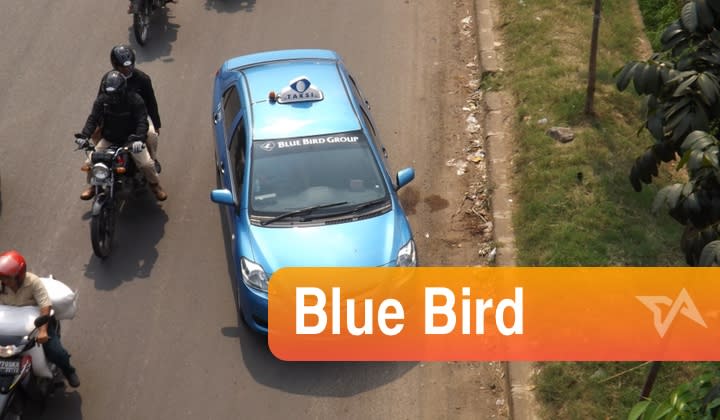
Car-hiring and taxi-flagging haven’t yet become very web-connected in Jakarta or across Indonesia, but the well-established taxi firm Blue Bird is making some ground with this new breed of apps.
Blue Bird’s app lets regular riders order a car and track its arrival through the traffic. The company hasn’t yet made a web service that connects with its higher-end Silver Bird car fleet, even though that would make it into a sort of homegrown Uber.
Blue Bird has an app for Android.
Go-jek

In many Asian cities, motorbikes remain the top form of transport. They’re also a good way of weaving through Jakarta’s traffic. The team at Go-jek co-ordinates a fleet of bikes – known locally as ‘ojek’ – that can be hired via the website (no apps yet).
The idea is to serve as a safe middle-man between bike riders and customers, and also to reduce the amount of time that motorcycle taxis spend idle.
However, the service seems to have become – at the behest of users – a sort of courier-finder service, as 70 percent of rides are ferrying items rather than actual passengers. It covers hundreds of riders across the Jabodetabek area (Jakarta, Bogor, Depok, Tangerang, and Bekasi).
Go-jek founder Nadiem Makarim quit his role at Zalora Indonesia as managing director in order to work on this startup.
(See: Tesla has announced the price of the Model S in China, and it’s much lower than expected)
India
There’s plenty of competition across all kinds of app-connected four-wheel transportation in India. If you don’t want to drive, there’s Uber or a homegrown challenger in the form of Savaari. If you need a simple cab, there’s Ola or TaxiForSure. Or if you want to drive, Zoom is a useful rental aggregator. Let’s focus on India’s biggest and most proven transport app:
Ola
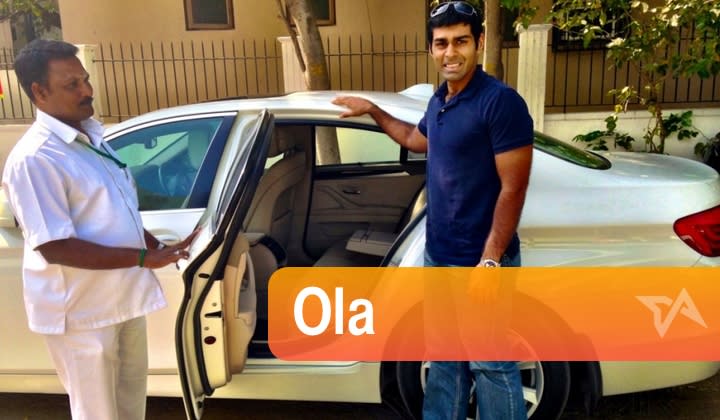
India’s Ola covers taxi booking and the more recent – and very Uber-esque – Ola Luxury service. Currently it covers taxis and private car fleets in Mumbai, Delhi, Bangalore, Pune, Chennai, Jaipur, and Goa. There’s also Ola Mini for smaller and cheaper cabs, which is running only in Bangalore and Delhi so far.
The taxi-booking service, Olacabs, has 9,000 vehicles in its network. All the taxis and limos belong to third-party cab firms and livery operators. (Update: Corrected an error about offering rental cars).
Its most recent investment is $20 million in series B funding last November.
Olacabs has apps for iOS and Android.
Vietnam
As EasyTaxi and GrabTaxi battle for Vietnam’s motorbike-filled roads, a local startup is getting in on the action as well.
PingTaxi
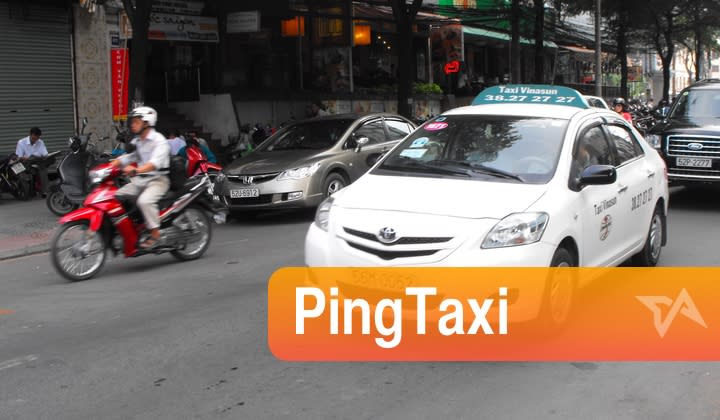
This is the homegrown challenger battling the might of EasyTaxi. The trouble is that the startup lacks the funds to run adverts to lure in new users or to pay out significant cash bonuses to attract new drivers to sign up.
In October last year when we last reported on the startup, PingTaxi was in the very early stages with 110 drivers on the platform and 3,000 users on the app.
PingTaxi has apps for iOS and Android.
Philippines
Quite a few people in Manila are trying to beat Manila’s awful traffic by ride-sharing – otherwise known as carpooling. There are quite a few apps tapping into that market, like RideFind and Tripid – the latter of which is the biggest in the country.
Tripid

Tripid is about car-sharing – in the sense of hitching a ride, not borrowing a car and getting behind the wheel.
Users with a car can post a notice of their journey – usually a regular one, such as a commute – and then other people can opt into the carpool. Riders pay for the trip via an ewallet made up of Tripid credits, so the ride is made more seamless by being cash-less.
By October of last year it had 3,500 users on the web app, with 12,000 trips posted.
While it’s a nice idea, authorities in the Philippines are not so keen and keep a critical eye on both Tripid and Uber. In mid-February, the country’s Land Transportation Franchising and Regulatory Board ruled that they’re both technically illegal and must secure a franchise. While Uber has local partners it can lean on, Tripid might be on shakier ground as a purely crowdsourced service. The two transportation apps will be called to a public hearing to testify on this issue.
Tripid has apps for iOS and Android.
NOTE: This article appeared earlier in the TiA Emag, which is exclusive to our Premium subscribers. Find out more about TiA Premium.
(Lead image credit: Creative Commons-licensed photo by Flickr user alancleaver)
The post Reinventing four wheels: 14 apps that are changing the way we get around appeared first on Tech in Asia.

 Yahoo Finance
Yahoo Finance 
